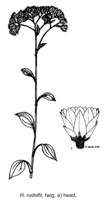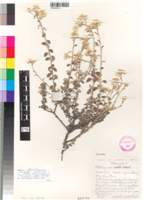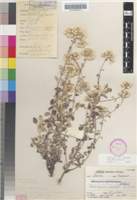Diagnostic characters:
Compact branched inflorescenceCream bractsLarge heads
Description:
Shrubby, up to 1 m tall, branches greyish-white felted, closely leafy, more distantly so on flowering twigs. Leaves 10�40 x 3�30 mm, diminishing slightly upwards, rhomboid-elliptic or ovate, gradually, or sometimes abruptly, tapering to a slender petiole roughly � to nearly � the total leaf length, base expanded, half-clasping, apex acute to very acute in narrower leaves, mucronate, margins flat, upper surface thinly and persistently woolly, glandular-puberulous beneath the wool, lower surface white-tomentose. Heads homogamous, campanulate, 5 x 4�5 mm, double that across the radiating bracts, many in cymose-corymbose clusters terminating the branchlets. Involucral bracts in c. 5 series, outermost short, inner subequal, very loosely imbricate, slightly exceeding flowers, subacute to obtuse, smooth or slightly crisped, glossy, tips opaque white. Receptacle with fimbrils exceeding the ovaries. Flowers 21�32, yellow. Achenes 1 mm long, � cylindric, obscurely and irregularly ribbed, glabrous. Pappus bristles many, equaling corolla, scabrid, bases cohering strongly by patent cilia.
Flowering mainly between April and June, but flowers can possibly be found in any month.
Distribution:
Grows among rocks on the mountain tops. Mainly found in the Mpumalanga mountains, and recorded from about Woodbush south to Elandshoogte near Machadodorp.
Grassland and Savanna Biomes.
Notes:
Easily confused with H. mimetes, but distinguished by its smooth white involucral bracts.
Taxonomy:
Literature:
Helichrysum rudolfii Hilliard in Notes R. bot. Gdn Edinb. 40: 265 (1982).
Type:
Mpumalanga, 2530 BA, Sabie to Lydenburg, Long Tom Pass, 15 iii 1981, common on rocky banks and low cliffs, Hilliard & Burtt 14363 (NU, holo.; E; K; M; PRE; S, iso.).
Synonym(s):
Vouchers:
Kerfoot 7894 (J; NU; PRE); Meeuse 9987 (M; PRE); Stirton 1820 (K; PRE).



